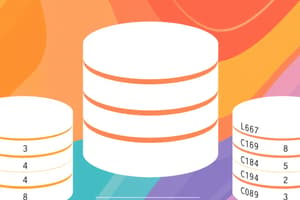Podcast
Questions and Answers
Why is normalization important in database management systems?
Why is normalization important in database management systems?
Normalization is important to eliminate redundancies, inconsistencies, and anomalies in data, making it easier to manage, more efficient, and less prone to errors.
What is the main goal of normalization in a database?
What is the main goal of normalization in a database?
The main goal of normalization is to improve the structure of a database by eliminating redundancies, inconsistencies, and anomalies.
How does normalization help with data integrity?
How does normalization help with data integrity?
Normalization helps ensure the consistency and accuracy of data, reducing the likelihood of inconsistencies and errors.
What is the purpose of normalization in databases?
What is the purpose of normalization in databases?
What are the benefits of normalization in database management systems?
What are the benefits of normalization in database management systems?
What is the goal of the First Normal Form (1NF) in normalization?
What is the goal of the First Normal Form (1NF) in normalization?
What does the Second Normal Form (2NF) aim to achieve?
What does the Second Normal Form (2NF) aim to achieve?
How does the Third Normal Form (3NF) improve database organization?
How does the Third Normal Form (3NF) improve database organization?
What is the purpose of denormalization in databases?
What is the purpose of denormalization in databases?
Why is it important to balance the tradeoffs between storage and processing efficiency in database management?
Why is it important to balance the tradeoffs between storage and processing efficiency in database management?
Flashcards are hidden until you start studying
Study Notes
Diving into Database Normalization: Keeping Information Tidy and Efficient
When it comes to managing data in a database, normalization is a crucial concept that ensures our information stays tidy, consistent, and easy to maintain. In this article, we'll explore what normalization is and why it's essential to keep your database in top form.
What is Normalization in Database Management Systems?
Normalization is a process used to improve the structure of a database. It aims to eliminate redundancies, inconsistencies, and anomalies that might arise as data grows, ultimately making data easier to manage, more efficient, and less prone to errors. By following certain rules, or normal forms, we can transform a database into a more organized and optimized form.
Why Normalize Your Database?
Normalization provides several benefits to database management systems, including:
- Data Integrity: Normalization helps ensure the consistency and accuracy of data, reducing the likelihood of inconsistencies and errors.
- Less Redundancy: Repeating data increases storage requirements and slows down database operations. Normalization reduces redundancy and improves processing efficiency.
- Simplified Data Updates: Normalization simplifies data updates because changes to a single record affect fewer other records.
- Efficient Data Retrieval: Normalization improves data retrieval as queries can be written to access specific data across multiple tables, producing more efficient results.
The Normal Forms
Normalization is typically done in several steps, each achieving a higher level of organization:
- First Normal Form (1NF): Remove repeating groups and create separate tables for each distinct entity.
- Second Normal Form (2NF): Remove partial dependencies and create tables based on full dependencies.
- Third Normal Form (3NF): Remove transitive dependencies and complete the process of separating entities into independent tables.
- Fourth Normal Form (4NF): Remove multi-valued dependencies and ensure each table has a single determinant.
- Fifth Normal Form (5NF): Remove join dependencies and create tables that do not require joins to resolve dependencies.
A Note on Denormalization
While normalization is a valuable tool, there are cases where denormalization—the intentional presence of redundant data—can improve performance in read-heavy applications. By denormalizing data, developers can reduce the time needed to retrieve information because complex queries can be simplified and executed faster, at the expense of storage space and update efficiency.
Conclusion
By understanding database normalization and its principles, developers and database administrators can optimize their databases, ensuring data is more organized, efficient, and accurate. While normalization is a complex topic, knowing its basics can help us make better decisions when managing our databases.
Remember that normalization is not a one-size-fits-all solution. The specific normal form to use and whether denormalization is appropriate depend on the specific needs of the database application. As always, balancing the tradeoffs between storage and processing efficiency is essential to make informed decisions that best serve the needs of our applications.
Studying That Suits You
Use AI to generate personalized quizzes and flashcards to suit your learning preferences.




